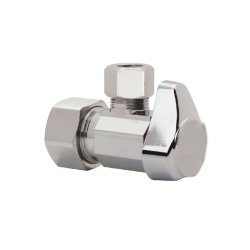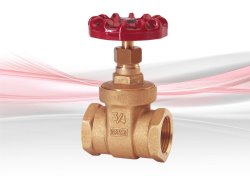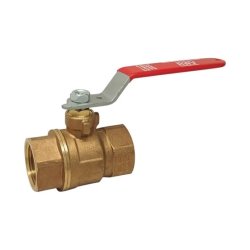 | | | Angle Stop Ball Valve Photo provided | | | | | | One of our greatest creature comforts in modern life is the availability of hot and cold running water in our homes. We take this for granted because it is so reliable and constant. Consider how many times each day we wash hands, dishes, clothes and bodies, water gardens, flush toilets, and clean our homes. All this water is readily at hand thanks to the pipes and control valves that are built into the home. Most of the time we don't think about them because they work so well, but sometimes things can go wrong.
 How wrong? A client once asked me to determine why only the hot water side of a bathroom faucet had very low pressure. I reached under the sink and screwed the shutoff valve closed so I could assess the problem. The faucet did not stop running completely, but it was only trickling, and I decided to proceed.
How wrong? A client once asked me to determine why only the hot water side of a bathroom faucet had very low pressure. I reached under the sink and screwed the shutoff valve closed so I could assess the problem. The faucet did not stop running completely, but it was only trickling, and I decided to proceed.
 I removed the cartridge from the hot side and found small bits of debris in the valve. I reached under the sink and opened the shutoff valve a little to clear the line of debris. What a mistake! Those bits of debris in the faucet turned out to be the brittle remains of the shutoff valve's washer and my attempt to shut off the now open valve was futile, because there was nothing left to seal the valve opening. As hot water gushed unabated into the sink, I ran outside to shut off the house main valve. The house main was an old gate valve which slowed but did not completely shut off the flow of water. I found the water heater (in the garage) and shut off the ball valve there and was able to complete the repair. All in all, no damage done except my temporarily elevated blood pressure.
I removed the cartridge from the hot side and found small bits of debris in the valve. I reached under the sink and opened the shutoff valve a little to clear the line of debris. What a mistake! Those bits of debris in the faucet turned out to be the brittle remains of the shutoff valve's washer and my attempt to shut off the now open valve was futile, because there was nothing left to seal the valve opening. As hot water gushed unabated into the sink, I ran outside to shut off the house main valve. The house main was an old gate valve which slowed but did not completely shut off the flow of water. I found the water heater (in the garage) and shut off the ball valve there and was able to complete the repair. All in all, no damage done except my temporarily elevated blood pressure.
 Now, about those valves. There are three basic types of valves used in homes: ball, globe, and gate.
Now, about those valves. There are three basic types of valves used in homes: ball, globe, and gate.
 In older homes, the main shutoff valve is usually a gate valve. Gate valves have a handle that you turn and turn and turn to close or open. The gate valve has a plate (the "gate") inside, which slides between two walls to allow or block the flow of water. They are typically made of brass and may be problematic as they age. The problem is that if it stays open for a prolonged period, the slide gate and walls can collect corrosion and debris, which can prevent the valve from shutting off completely when you need it. An ounce of prevention: routinely shut it and open it every four months to keep the edges clear.
In older homes, the main shutoff valve is usually a gate valve. Gate valves have a handle that you turn and turn and turn to close or open. The gate valve has a plate (the "gate") inside, which slides between two walls to allow or block the flow of water. They are typically made of brass and may be problematic as they age. The problem is that if it stays open for a prolonged period, the slide gate and walls can collect corrosion and debris, which can prevent the valve from shutting off completely when you need it. An ounce of prevention: routinely shut it and open it every four months to keep the edges clear.
 The shutoff valves under your sinks are typically globe valves. Globe valves also have a handle that you turn multiple times to open or close. The difference is that they have a washer or disk that fits over an orifice in the valve to control the flow of water. Again, a problem arises when the washer gets brittle and cracks or breaks and no longer completely shuts off the flow of water. This can make installing a new faucet difficult.
The shutoff valves under your sinks are typically globe valves. Globe valves also have a handle that you turn multiple times to open or close. The difference is that they have a washer or disk that fits over an orifice in the valve to control the flow of water. Again, a problem arises when the washer gets brittle and cracks or breaks and no longer completely shuts off the flow of water. This can make installing a new faucet difficult.
 The best valve to have is a ball valve. You know it's a ball valve because it only needs a quarter turn to shut on or off. The valve is a solid housing with a ball inside; the ball has a hole through it. When the hole is aligned with the pipe, water flows through. When you turn the handle (a quarter turn), the solid side of the ball blocks the flow of water. An additional benefit of ball valves is that the handle tells you if the valve is open or closed. When the handle is aligned with the pipe, the valve is open; when the handle is perpendicular to the pipe, the valve is closed.
The best valve to have is a ball valve. You know it's a ball valve because it only needs a quarter turn to shut on or off. The valve is a solid housing with a ball inside; the ball has a hole through it. When the hole is aligned with the pipe, water flows through. When you turn the handle (a quarter turn), the solid side of the ball blocks the flow of water. An additional benefit of ball valves is that the handle tells you if the valve is open or closed. When the handle is aligned with the pipe, the valve is open; when the handle is perpendicular to the pipe, the valve is closed.
 Hopefully, you can enjoy the pleasure of running water in your home without adversity. Should you ever need to replace a defective shut off valve, I highly recommend installing a new ball valve in its place.
Hopefully, you can enjoy the pleasure of running water in your home without adversity. Should you ever need to replace a defective shut off valve, I highly recommend installing a new ball valve in its place. |



